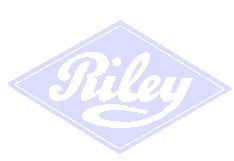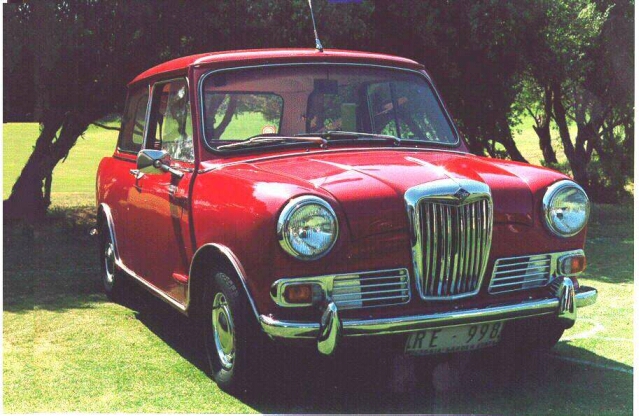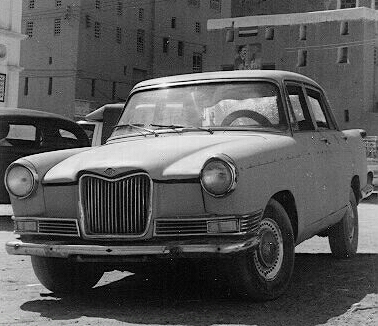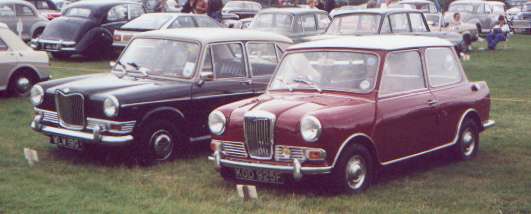|
Car Name |
Riley.
Farina |
Model |
4/72 |
Year |
1964 |
 |
Description
|
Personal
History |
| Serial
Number:5316425 |
| No.
of Cylinders: 4 -1622 cc |
| Engine
Tag No:5289 |
| Units
In Stock: 1 |
| TRANSMISSION
Overall gear ratios.
1st 15.64
2nd 9.52
3rd 5.91
4th 4.33
Reverse 20.45
DIMENSIONS
Wheelbase 8'4" (aprx
2550mm)
Track 4'3.5" (aprx 1300mm)
Length 14'11.5" (aprx 4560mm)
Width 5'3.5" (aprx 1610mm)
Tires 5.90x14
Weight 21.75cwt
Fuel Tank 10galls
SUSPENSION
Independent Coils at Front
Semi Elliptic at rear |
- BRAKES
- Girling hydraulic drum
- brakes with
wedge operated
- shoes
9in drums.
|
|
|
|
|
B-Series
Farina 4-Door Saloon
The 4/72 replaced the 4/68 in October
1961, and was essentially the same car. The 2 big differences was the
enlarged 1622cc B-Series Engine, and the redesigned tail-fins. The car
also featured front and rear anti-roll bars, wider track and an automatic
option.
The car was also marketed as every other
BMC Marque, like the 4/68 before it, but got killed off early, in 1969,
when BLMC decided that the Riley Marque was a drain, down which their
money was disappearing. |

More Details Will Be Added
Soon, YCC
سنظيف
المزيد من
المعلومات
في القريب
العاعجل
فضلا زرنا
مرة اخر
|
|
Links
|
Industry
History |
|
|
|
|
|
 | Riley
Register: The
Riley Register is the club for owners of pre-war Riley cars |
|
|
|
 | Riley
Club Victoria
Pages setting out activities and aims of the
Riley Club in Victoria with links to images of members cars,
history and other Riley related items of interest.
|
|
-
|
-
|
-
|
-
|
-
|
-
|
-
|
-
|
-
|
-
|
-
|
|
Riley's - The BMC Years
The End of a Great Marque
The year 1957 saw great changes for Riley.
The last Car that could be described as a real-Riley was shelved and
replaced with a Wolesley. The Two-Point-Six
was essentially a Wolsley 6/90 with a different Radiator.The engine was a
tuned BMC C-series 2.6litre 'six', used in the Wolsley and also the large
Morris and MG saloons of the time. The interior was also largely the same
as the Wolsley, and apart from extra speed the 2 handled the same as
well.The same year the delayed replacement for the RME was launched,
originally intended to be a Morris Minor replacement, the car was adapted
with more luxury appointments to provide both Riley and Wolsley with a new
small model. Called the One-Point-Five
by Riley, and also the Wolsley 1500 it was again essentially a Wolsley
with a different radiator, tuned engine and different trim. However, the
car sold extremely well, beating all other Riley Models with over 30,000
cars built!In 1959 the 2.6 was replaced by the 4/68,
the Riley version of BMCs ubiquitous B-series Farina Models. It was
powered by the same 1489cc B-series engine as the 1.5, but still somehow
appealed to a differnet market, largely due to the bidder more roomy
bodywork.
It was replaced by the 4/72 two years later, which had the larger 1622cc B-series engine intorduced
earlier in the year. This car soldiered on until the death of Riley in
1969, albeit with miserable sales figures and stiff in-house competition
(from Wolsley and MG). Also launched
in 1961 was the Riley
Elf. Again this was a cosmetic job on a Wolsley Model, this time the
Wolsely Hornet, itself based on the Mini. The Elf was another good seller
for Riley, but wasn't enough to keep the marque alive.
1965 saw the end of the 1.5, being replaced by the smaller Kestrel
1100 A-series Farina Model, again another cross-BMC car. The car was
updated in 1967 as the 1300,
with the larger 1275cc Mini Cooper engine, but the 1100 was phased out in
1968 and the 1300 in '69.Riley's demise was caused by a variety of
factors, being:The falling sales. The public complaints against BMC
rubbishing Riley's Heritage with a range of lacklustre saloons. The Huge
Financial Troubles experienced by the new British Leyland Motor
Corporation (from the merger of BMC, Jaguar-Daimler, and Leyland
(Rover/Triumph). A lack of funds for new models for so many marques. The
close competition between Riley, MG, Wolsley and Triumph's Models. These
all combined to force BLMC to kill off The Riley Marque. Within the same
12 months Vanden Plas and Austin Healey also went, and by 1975 Wolsley had
followed. However, all is not lost - there could yet be a future for
Riley.
|
- Rileys 1896 - 1939 The Pre-Nuffield
Years.
- The Beginnings of a Marque.
- 1896-1914
. The Riley Cycle Co. Ltd. was founded on
23/5/1896 by William Riley Junior. In 1870, he had taken over the families
weaving business, in Coventry. In 1890 he also acquired the Cycle works of
Bonnick & Co. Ltd. The two companies were effectively merged in 1896,
with new works being bought alongside the Bonnick works in King Street
Coventry. In 1899, the first Rileys powered by an internal combustion
engine were shown. They were a Quadricycle, and a Tricycle, both called
'Royal Rileys'. They were shown by the company of Messers William, Basil
and Herbert Riley - the three brother shareholders of the company. These
were the first official Rileys to be offered for sale to the public.
However, between 1896 and 1898, Percy Riley, one of William's sons, had
developed a car
of his own. The Car was hand-made by Percy, to his own design, in the
Workshops of the Riley Cycle Company, however, it was never put into full
production. The only thing of note in his design, was that for the first
time in a cars engine, he used a mechanically-operated inlet valve.
However, although this car was a very successful prototype, which was used
by the family for many years, it didn't reach production, meaning that the
1899 Royal Rileys are thought of as the first Riley Motor Cars.
Over the next few years, Riley developed
the 2 Royal Riley designs, as well as adapting some of their bicycle
designs to take petrol engines. However, the directors were beginning to
find the problems in simply adapting pedal-driven machines to
petrol-driven, and so decided to design a tricycle that was intended to be
motorized from the beginning. This resulted in the 1904 Tricar. The Tricar,
although obviously based on the Motor-cycles, was undoubtedly designed to
be petrol-driven (as indeed was the 1903-model motorbike). It featured the
first Riley-designed engine, from the Riley Engine works, run by 3 of
William Riley's Sons - Percy, Victor and Allan. The engine works were run
entirely by Percy, and situated alongside part of the 13th century city
wall in Coventry. The 1905 Tricar was the first Riley to use a steering
wheel in preference to Handlebars. It also had some form of bodywork, and
started to look less like a converted Motorcycle. This also meant that the
saddle was replaced with a bucket-seat, like that already used for the
passenger. These 9hp Riley Tricars were the first to enter motorsports,
and their success lead to Rileys inter-war domination of their class at
many races. Over the years, the Tricar design was developed significantly,
until it ended production in late 1907, due to more modern 4-wheeled
Rileys.
Since 1905, a 'proper' 4-wheeled Riley had
been under development, and was ready for production towards the end of
1906. The development of this car had lead to the Riley Engine Co. having
to move in that summer. This was done with the aid of a lorry that they
specifically built themselves, and was able to carry up to 2 tons, simply
using the v-twin 9hp engine from the Tricars. The
Car was a light 2-seater, using the V-twin engine, and available with
an optional hood. Throughout 1906 and 1907, the cars were successful in
many of the events (mainly hillclimbs) that they were entered in, winning
a large number of them outright, although mainly due to Handicapping
procedures.. A significant development that Riley used on this car, was
the patented detachable wheel, which meant that the puncture didn't have
to be repaired in-situ, but the wheel could simply be replaced. During
this period, the success of the cars led the Riley Cycle Company to cease
production of bicycles by 1911. However, before this, in late 1907, Riley
had decided that a larger car was necessary. Therefore they had developed
the Riley 12-18hp. This still used a V-twin engine, but scaled up to about
2 litres. The car was usually a 4-seater, but had many different bodies
put on it in it's lifetime. These bodies included a Landaulet, 2-seater,
and 4-seater with rearward facing rear seats. Most models featured
tool-trays under the front passenger seat, an idea which was used on many
further Rileys (although later transferred to an under-bonnet location).
By the 1908 Motor Show, another new model had been launched, in the shape
of the Riley 10hp.
This was generally a 2-seater model, with a shortened chassis, and smaller
engine than the 12-18hp. Most of the development of the Riley Cars was now
being carried out by Percy (Engines/Mechanics) and Stanley (Body design).
The other family members played lesser parts as controllers of the various
Riley companies.
During 1910, the 9hp model was gradually
phased-out, leaving the company running a 2-car production line. Then,
during 1913, many changes were made in the Company infrastructure. The
Riley Motor Manufacturing Co. took over car production, at new works next
to the Riley Engine Co., and the Riley Cycle Co. changed it's name to
Riley (Coventry) Ltd., and concentrated on the patented detachable wheels.
These wheels were to prove very popular with other manufacturers, and in
1913 alone, Riley supplied over 183 manufacturers with wheels. During this
period of reorganisation, a brand new car, The Riley 17hp was launched. It
featured a brand new 4-cylinder, 3 litre engine. Again various bodies were
available, but production hardly got under way before war was declared.
|
| |
Condition
|
| |
The
car is in a very good condition. The original engine still in great
condition, the body has no dent, Lead Time and the interior is clean with
clothed seats. Running until 1982. |
| |
| |
|
Similar Model |

 |
|
Actual Model |
|
- Actual Model

-
- Actual Model

|
|
- Similar Model

|
Similar
Models
|
|
|